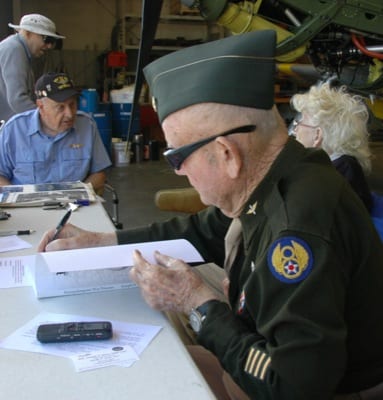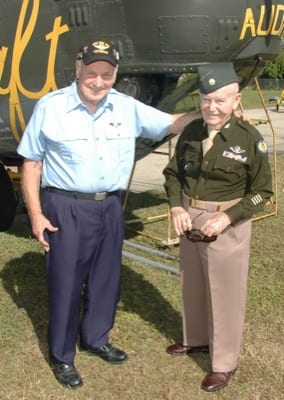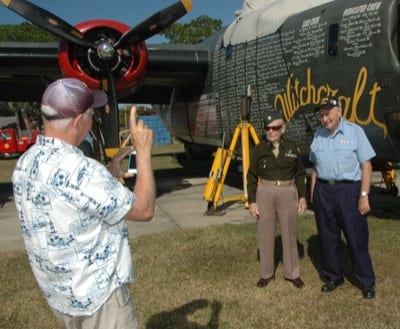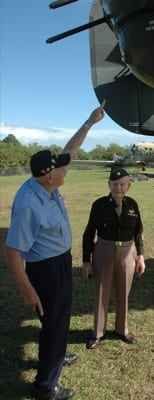By BILL WALKER
Decorated U.S. Army Air Corps fliers Joseph Reus and Sam Mastrogiacomo took center stage at the last American Aero Services open house at New Smyrna Beach Municipal Airport (EVB) in Florida. On the ramp outside the hangar entrance where the two airmen signed copies of their memoirs, an airworthy B-24 Liberator provided a vivid reminder of their service in World War II.
Reus, a Liberator navigator, flew two missions over Germany and his aircraft went down both times. He was captured after the second mission and spent more than a year in a German prisoner of war camp. Mastrogiacomo, a Liberator tail gunner, was interned for several months after his plane was forced down in Swedish territory. He was in the 702nd Bomb Squadron and Reus in the 703rd Bomb Squadron of the 445th Bomber Group (H) commanded by Captain Jimmy Stewart, a decorated bomber pilot who was also a movie star.

Reus, who retired from the U.S. Air Force in 1965 as a major, wrote “Kriegsgefangener: War Prisoner” in 2011. His first mission as a navigator was Dec. 30, 1943. The target was a chemical factory at Ludwigshafen on Germany’s Rhine River. Reus’ Liberator was heavily damaged by anti-aircraft fire and four of the 10-member crew died when the plane eventually ditched in the English Channel. Reus, a 21-year-old first lieutenant from Baltimore, survived, but suffered broken arms, bullet wounds, burns and other injuries.
He could have returned to the U.S., but asked permission to stay with his unit. “Our commander, Captain Jimmy Stewart, drove the 150 miles from our base at Tibenham to the hospital near Salisbury to bring me my uniform so I could return,” Reus recalled.
He volunteered for duty before his recuperation was complete and flew out on his second mission Feb. 24, 1944. The target was a Messerschmitt aircraft factory near Gotha, Germany. “The mission began our part of Operation Big Week, which was a six-day bombing campaign to attack and destroy all Axis aviation-related industries in Germany and Occupied Europe,” Reus said. The 445th earned the Distinguished Unit Citation for this attack.
Reus’ Liberator was hit southwest of Fulda, Germany, by a rocket fired from a twin-engine BF-110 Zerstorer. The crew bailed and Reus was captured by local citizens and eventually transported to Stalag Luft I at Barth, 30 miles east of Rostock, a city near the Baltic Sea. He was freed in May 1945 and flown out of Germany on May 13.

Staff Sergeant Sam Mastrogiacomo, a 20-year-old from Philadelphia, had already been on a dozen missions when his unit was assigned to attack an aircraft factory at Tutow, Germany, on April 13, 1944, Easter Sunday.
“It was my 13th mission but that didn’t worry me,” he said. “I wasn’t exactly superstitious but since I had 13 letters in my last name, and my Army serial number started and ended with the number 13, I would feel lucky when the mission was over.”
His aircraft was hit by fighters just after dropping its bombs over the target and quickly fell behind the formation returning to England. “One engine was burning,” he recalled. “We were stragglers and meat for the German Luftwaffe. To make it even worse, our number four engine was leaking oil.”
The crew decided to set a course for neutral Sweden, 100 miles away. “We said that anything would be better than being POWs by the Germans,” Mastrogiacomo wrote in his 2011 book, “For God And Country In That Order.”
They turned toward the Swedish coast and the pilot took the Liberator down low over the water. Mastrogiacomo spotted three Focke-Wulf 190 fighters coming right at him. “As the lead plane stuck his nose out,” he wrote, “I gave him a blast! They were looking us over like a prizefighter looking for an opening. The three of them came right at our tail and I got one of them. He spun out and crashed into the sea.” A second plane was hit and the third turned back to Germany.
The crew began dumping everything not bolted inside the aircraft to lighten the load. As Mastrogiacomo was about to push his guns out, he spotted another aircraft approaching and prepared to fire. “At that moment,” he said, “the plane flipped his wing over, and we saw his insignia, a blue circle with three crowns.” A Swedish aircraft. “The plane led us to a fighter strip on an island between Sweden and Denmark,” he continued. “A second B-24, this one hit on a raid over the Ploiesti oil fields in Rumania, landed after we did.” Both crews were taken along with other internees to a camp in the Swedish interior.

Mastrogiacomo’s escape from Sweden in summer 1944 was high adventure. He was among 35 other internees allowed to cross an embankment onto a runway where a B-24 sat with propellers turning. There were no seats and most of the men were forced to crowd into the plywood reinforced bomb bay for the flight. “We were told as we took off that the Swedes were going to shoot at us, but not to worry, they wouldn’t hit us,” he recalled. “Sure enough we were roaring down the runway for takeoff. As we did this, we heard the whistling of bullets flying past and alongside of our airplane and none of them hit us.”
Mastrogiacomo entered the military reserves after the war and retired as a senior noncommissioned officer following duty during the Korean War and the Cuban missile crisis.
He said there was one big piece of unfinished business concerning his combat missions over Europe. “After shooting down five aircraft from my tail gunner position I should have been awarded the Distinguished Flying Cross,” he said. “But the paperwork never went through.”
That changed on Oct. 4, 2003. “I was presented the Distinguished Flying Cross by Brigadier General Christopher Joniec, Commander of the 514th Air Mobility Wing, McGuire Air Force Base, New Jersey after 59 years. I received this with my wife Joan and 28 family members and friends present.”
These days, when the Collings Foundation B-24J is parked at American Aero Services for its annual inspection, Mastrogiacomo is often on hand as well. He serves as a guide for visitors who want to know more about the aircraft and points with pride to his name just above the tail gunner position that was his workplace on another Liberator.

Reus flew rescue operations after World War II in SA-10 Catalina flying boats, then B-29s on combat missions over North Korea. He ended his career as a B-52 navigator. In May 2011 he was selected from a group of Volusia County, Fla., Honor Flight veterans to place a wreath at the Tomb of the Unknowns in Arlington National Cemetery. He, too, is a frequent visitor to American Aero when the B-24 is in town.
The importance of a visit by Reus and Mastrogiacomo was not lost on American Aero Services owner Gary Norville, who pointed out that the country is losing World War II veterans at the rate of nearly 800 each day.
“It is special for adults and children to make contact with genuine American heroes like Joseph Reus and Sam Mastrogiacomo,” Norville said.

Dad, I’m so proud of you!
I wasn’t aware that you had written a book filled with the stories I had heard as a child. I sure would like an autographed copy.
The photographs in the article are terrific; you look wonderful.
How is Mom doing?
“REAL pilots from a REAL war”!
Perhaps it’s time for a remake of “12 O’Clock High”-
Harrison Ford as General Savage?
Please help us in the B-24 story by telling us the geographical location (airport name and day-month-year of the pics and story)with the dynamic 2 from decades ago WWII.
This seems like common sense from an informational perspective on the part of the author of the story and the editor of the infamous General Aviation News that has gone all out in its transition from a piece of paper @ FBO to an internet focus media with its format that is always developing into new forms. Keep up the good info dispersal by dating and location of your outstanding stories/pics.
Jim, American Aero Services is at New Smyrna Beach Municipal Airport (EVB) in Florida. Sorry for the oversight.